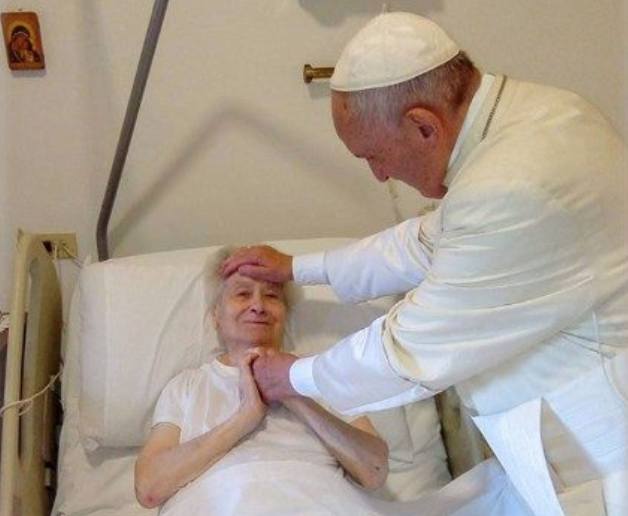Pope Francis’s surprise visit to the Vincentian Daughters of Charity last Sunday was not only another illustration of his personal affection for those around him, but it also shed light on the order itself, which has a history of serving popes and which seems to be emerging as a Francis favorite.
Not only do the Daughters of Charity of St. Vincent de Paul run the Vatican’s Santa Marta guesthouse, where Francis resides, but on July 8 he named the order’s superior general, Sister Kathleen Appler, a full member of the so-called Congregation for Religious.
Appler was one of seven women to be named full members, marking the first time women had been included among the ranks of what had until then been a male-dominated office. A native of Utica, New York, Appler leads a global community of some 14,500 sisters who live and work in 94 countries.
Sunday afternoon, the pope stopped by the Daughters of Charity convent in Rome to visit ailing Sister Sister Maria Mucci, who is currently in the infirmary after undergoing a risky surgery in October, but who for years has worked in the kitchen at the Santa Marta residence.
During his visit, the pope stopped to pray in front of the bloodstained undershirt worn by St. Pope John Paul II when he was shot in 1981. It was gifted to the sisters after John Paul left Rome’s Gemelli hospital, where he received treatment.
Yet in addition to Francis and John Paul II, the Daughters of Charity also had close ties to another pontiff, Pope Leo XIII.
Founded in 1633 by St. Vincent de Paul and two French women, St. Louise de Marillac and Marguerite Naseau, the order is dedicated to serving the poor, primarily through missionary work.
They work with addicts, migrants, homeless, women, children, prisoners and the disabled, among others, and members are present in Africa, Asia, North America, Europe, Central and South America, and Australia and Oceania.
In 1884 Pope Leo XIII asked the order to take charge of what was then the “St Martha Hospice” center, where, according to an article on the formal website for all branches of the Vincentian spiritual family, “famvin,” the sisters served the poor, welcomed pilgrims and ran a dispensary.
During a cholera epidemic that hit Italy in the late 19th century, Pope Leo XIII asked the sisters specifically to welcome and care for patients at the hospice.
In 1887, Leo instituted a jubilee and decreed that the hospice be used as a place to host pilgrims with modest incomes, who were allowed to stay free of charge during the jubilee year, which traditionally happens every 25 years in the Catholic Church and is considered a “holy year” marked by celebrations and a strong emphasis on pilgrimage and repentance.
During the Second World War the hospice also housed refugee ambassadors who were unable to stay in Rome.
It still functions as a residence today under its current name, the Saint Martha house, which Francis opted to live in following his election to the papacy in March 2013, rather than the traditional papal apartments in the Vatican’s apostolic palace.
Still welcoming Vatican visitors despite the pope’s presence, Santa Marta regularly hosts cardinals, bishops and other high-profile guests who are visiting from abroad.
As of 2013, when Francis was elected, there were eight sisters working at the residence.
Francis has often praised the work of religious sisters and has frequently articulated a desire to include more women in the Roman Curia, including positions of leadership.
In comments to Crux, Sister Patricia Murray, executive secretary of the International Union of Superiors General (UISG), praised the attention Francis has shown toward women religions in general during his time in office. The Daughters of Charity are members of the UISG.
“We have appreciated greatly Pope Francis’s increased interaction with religious sisters. His approach is warm and authentic, and there has been real dialogue and openness,” Murray said.
Throughout his pontificate, Francis “has listened to our various requests and responded progressively to each,” she said, noting how the pope established a commission to study the women’s diaconate following a suggestion from sisters during the UISG 2016 plenary assembly.
Not only has Francis increased the number of women religious inside Vatican departments, including the appointment of Appler and six other women to the Congregation for Religious, but they now also have seats at high-level meetings previously only open to men as full participants, Murray said.
Among these meetings is the upcoming Synod of Bishops on the Amazon, which will be attended by 20 religions sisters, half of whom were named by the UISG.
“We as sisters feel respected, listened to and appreciated,” Murray said.

